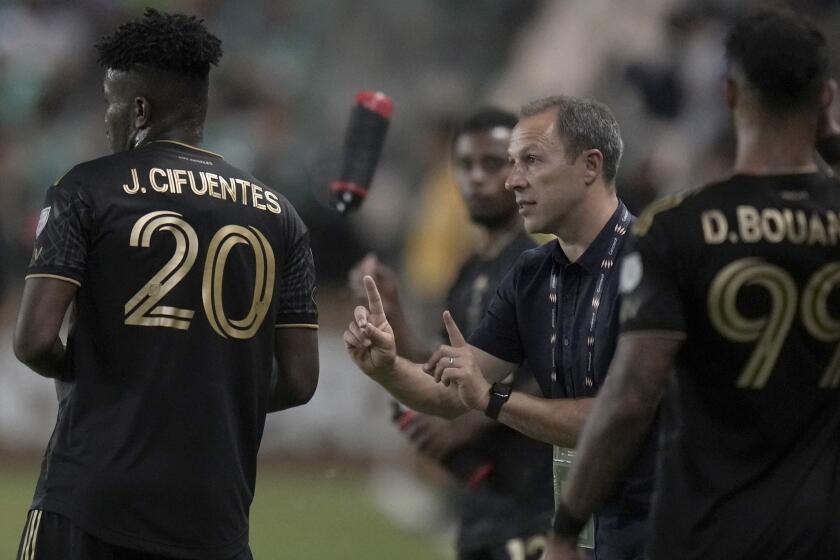Commentary : NCAA Commission Is Getting Its Act Together
- Share via
There is a word some of us, quite recently, thought might not be associated with big-time college sports for years. Or decades. Or even in our lifetimes. We dare now form it, slowly and boldly: H-O-P-E.
Impossible as it still may seem to certain cynics, a tiny snowball called reform has grown large enough to knock down a couple of dangerous fortresses and at least rattle a few others.
The NCAA Presidents Commission has done well. From 1984 through last week, it has gotten legislation passed that dramatically alters semiamateur athletics.
Give the prexies an interim grade of B, but suggest the possibility of an A if they get cracking on some other areas that need improvement.
Not so long ago, innocents shocked by misbehavior at some schools and scandals at others would ask: “Why haven’t the presidents charged into their athletic departments and straightened ‘em out?”
Wise old observers would reply: “Because they don’t know where the athletic departments are. And don’t care to inquire about directions.”
Well, the Presidents Commission, chaired by Maryland’s John B. Slaughter, has gotten interested and also forceful. In about four years, changes have come in the way:
--Athletes are recruited.
--Athletes are admitted.
--Athletes are kept eligible.
--Not bad work at all.
Some recent touch-up helps make the landmark Proposition 48--which was the brainchild of a group of presidents although it was passed a year before the commission was formed--more meaningful. Revisions to that rule were passed last week stating that anyone who fails to meet those eligibility guidelines can play for just three years.
Proposition 48 allows an athlete to be admitted, if he falls short of certain standards, but makes him ineligible his freshman year.
If that athlete were given four seasons of eligibility, his freshman year might well be nothing more than cosmetic fluff filled with easy-to-ace courses to give the appearance of scholarship bulk. Sort of an academic steroid.
Because he now has only three years in his sport, the first one in the classroom should be more important. Also, there is more incentive to excel academically in high school, so he will meet the Proposition 48 standards and have as long as his athletic peers to display his skills.
More significant last week were the scholarship cutbacks--from 15 to 13 total in basketball and from 30 to 25 a year in football--and the trimming of the recruiting process.
Although the scholarship reductions save money, they also help players whose egos are greater than their abilities. Too many waste their athletic lives in college by joining programs that are too competitive.
In the future, the 14th and 15th North Carolina bench sitters no longer will be high school All-Americans. Those former hotshots will be at a lower level, perhaps at William & Mary, playing regularly and still getting a quality education.
In football, the four-year number of scholarships remains at 95, but the cutback is designed to eliminate the possibility of players being run off so a coach can get back their spots after the team becomes overstocked.
Even more significant is the new rule that limits who can recruit a player and for how long. Boosters cannot have any contact with prospects; neither do coaches have almost unlimited access.
In football, the recruiting season has been slashed from five months to four. That means the coaches can spend more time where they belong, with current players and families.
“A very strong statement in terms of reducing recruiting emphasis and recruiting pressure,” said Pacific 10 Commissioner Tom Hansen, former No. 2 man to Walter Byers at the NCAA. “It’s a very bold package of proposals.”
Schools in talent-rich areas, such as Maryland, will benefit from these new rules. Non-elite schools will be hurt by the limited contact, but helped by the scholarship reductions.
The downside is that schools will be losing part-time assistants in basketball. Naturally, some coaches recoiled at the overall changes.
“What are we becoming, a totalitarian state?” said St. John’s Coach Lou Carnesecca, who might be the world’s only coach who yells quietly. “You got to study these things further.
“Is this a sinister move so we can make this a socialist state and cut things down so there is more to go around? They cut scholarships, which means freshmen will definitely have to play. I don’t see the rationale.”
Said Indiana’s Bobby Knight: “I’m so sick and tired of the things the NCAA comes up with. The Division I people have to get the hell out of the NCAA and form an organization of people who want to play the game and play it right and schedule things themselves and forget that b.s.”
Easy, Bobby.
Calm down, Looie.
There is more to be happy than sad about in these changes. You still will win more than most other coaches, because you’re better. Besides, Knight seems one of those perpetual grumps who faults any idea that did not originate in his own fine mind.
Before this piece gets mistaken for a blind-eyed hosanna, let it be emphasized that Slaughter and the other presidents still have much to reform--such as length of schedules, freshman eligibility and the format of basketball playoffs.
But, as sure as Carnesecca and Knight should put aside their own interests, the NCAA presidents also ought to think about coaches in their deliberations. For instance, if a school is going to monitor and control a coach’s outside income, it must guarantee the security that any lost revenue would provide.
Change does not have to be one-sided. A welcome scene at the NCAA convention last week was athletic directors and presidents fussing at one another. For ever so long, there was no dialogue at all.
More to Read
Go beyond the scoreboard
Get the latest on L.A.'s teams in the daily Sports Report newsletter.
You may occasionally receive promotional content from the Los Angeles Times.










